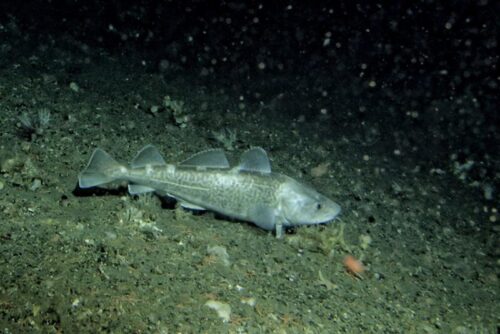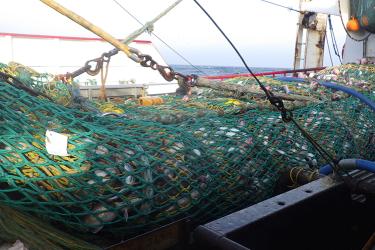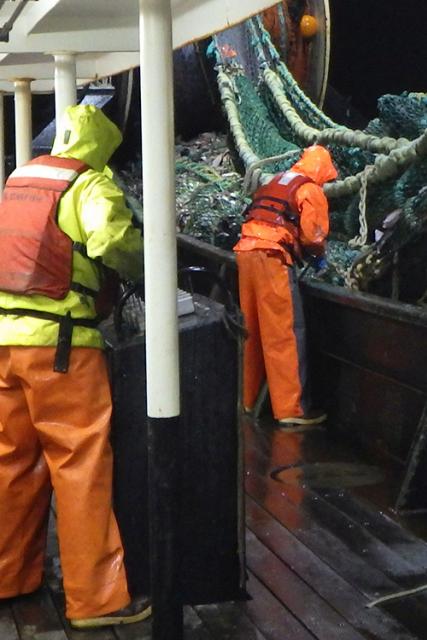
NOAA Fisheries AK To Implement New Pacific Cod Trawl Fishery Management
The following is courtesy of NOAA Fisheries Alaska:

NOAA Fisheries issued a final rule to implement a new program that will improve management of the Pacific cod trawl fishery. Amendment 122 to the Fishery Management Plan for Groundfish of the Bering Sea Aleutian Islands (BSAI) Management Area allocates Pacific cod harvest quota share to qualifying groundfish License Limitation Program (LLP) license holders and qualifying processors. It requires participants to form cooperatives to harvest the quota. A groundfish LLP license authorizes a vessel to participate in a BSAI groundfish fishery in accordance with specific stipulations. With some limited exceptions, the LLP requires that each vessel that participates in federally managed groundfish fisheries off Alaska be designated on a groundfish LLP license. The Amendment 122 regulations are effective on September 7, 2023. Fishing under the Pacific cod Trawl Cooperative (PCTC) Program is scheduled to start on January 20, 2024.
It is a limited access privilege program for the harvest of Pacific cod in the BSAI trawl catcher vessel sector. This is the first catch share program implemented in Alaska since 2012.
Over the last several years, total allowable catch for Pacific cod in the BSAI management area has steadily decreased. The pace of the trawl catcher vessel fishery has contributed to an increasingly shorter season. This has decreased the value of the fishery and negatively impacted all fishery participants (vessels, motherships, shoreside processors, and communities). It also discourages fishing practices that can minimize bycatch and threatens the sustained viability of the fishery.
The program was developed to improve the prosecution of the fishery, with the intent of:
- Promoting safety and stability in the harvesting and processing sectors
- Minimizing bycatch to the extent practicable
- Increasing the value of the fishery
- Providing for the sustained participation of fishery dependent communities
- Ensuring the sustainability and viability of the resource

Fishery Facts
The Pacific cod fisheries off Alaska are managed by both NOAA Fisheries and the North Pacific Fishery Management Council. They are managed under the Bering Sea/Aleutian Islands Groundfish Fishery Management Plan and the Gulf of Alaska Groundfish Fishery Management Plan. Pacific cod is the second largest commercial groundfish catch off Alaska, and nearly all of the United States. In 2021, commercial harvest of Pacific cod totaled 330.4 million pounds, worth $86.5 million.
There are four stocks of Pacific cod: Bering Sea, Aleutian Islands, Gulf of Alaska, and Pacific coast. In Alaska, scientists and managers determine the population status of Pacific cod based on estimates of spawning biomass. That’s a measure of the number of females in the population that are able to reproduce. Estimated biomass has fluctuated over the past few decades; the stock increased rapidly, peaked in the 1980s, and then declined slightly and stabilized.
Predominant gear types that are used for harvesting Pacific cod include:
- Trawl gear
- Longline (also called hook-and-line)
- Pots
In Alaska, measures to reduce bycatch of other species in the Pacific cod fisheries include prohibited species catch limits, gear type control, and modification plus seasonal and geographic restrictions. Some areas are closed to specific gear types in order to protect sensitive habitat and organisms.

Cooperative Fishing in Alaska
The Pacific Cod Trawl Cooperative Program joins other cooperative-based programs in Alaska. Other examples are the American Fisheries Act Program, Crab Rationalization Program, Central Gulf of Alaska Rockfish Program, and Amendment 80 Program. Generally, cooperative structures allow for more flexibility for participants throughout the fishing season. Some benefits include more efficient coordination of fishing operations, potential to reduce operational expenses, and increased quality and revenue from the product. Cooperatives are responsible for tracking the cooperative quota and prohibited species catch among their vessels. Cooperatives report on their previous years activity to the North Pacific Fishery Management Council every April. Cooperatives are responsible for paying their cost recovery fees to NOAA Fisheries. The cost recovery fee, not to exceed 3 percent of the ex-vessel value, is charged on all program landings to cover the actual costs directly related to the management, data collection, and enforcement of the program.
Starting in 2024, fishermen must have quota share and join a cooperative to participate in the A and B seasons of the BSAI trawl catcher-vessel Pacific cod fishery. The program assigns quota share to LLP licenses for Pacific cod based on legal landing associated with a qualified LLP. Legal landings are authorized, retained catch of Pacific cod caught by a catcher vessel using trawl gear in the BSAI during the historical directed fishing seasons. Eligible processors are issued a program quota share permit. The amount of quota share NOAA Fisheries issues is determined by the historical participation of harvesters as well as processors.
To use its quota share, an LLP license holder must join a cooperative and a processor must associate with a cooperative each year. The percentage of the quota share pool held by each LLP license holder and processor is combined with other participants within the cooperative. NOAA Fisheries, after setting the Pacific cod directed fishing allowance, issues a cooperative quota permit to cooperatives and applies the quota share percentages. This allows each cooperative to know how much Pacific cod can be caught. Each cooperative internally decides how much Pacific cod each of its cooperative members harvests.
The program requires at least three LLP licenses with program quota shares in association with at least one licensed processor to form a cooperative. Each cooperative receives an annual CQ permit, which is an amount of Pacific cod the cooperative is able to harvest in that fishing year. The program reduces halibut and crab PSC limits and annually apportions these limits to cooperatives based on the percentage of total BSAI Pacific cod cooperative quota allocated to each cooperative.
Pacific cod trawl harvest is apportioned by seasons:
- January 20 to April 1 (A season)
- April 1 to June 10 (B season)
- June 10 to November 1 (C season)

The program allocates only A and B season trawl catcher vessel sector
apportionments to cooperatives as cooperative quotas.
The C season apportionment is 15 percent of the annual trawl CV sector allocation. It remains a limited access fishery open to all trawl catcher vessels with LLP license endorsements to harvest Pacific cod with trawl gear in the Bering Sea and/or Aleutian Islands.
Some participants are subject to sideboard limitations. This prevents holders of quota share from expanding their fishing effort in Gulf of Alaska fisheries while still allowing cooperative members to catch up to the historical percentage of species they harvested in non-rationalized Gulf of Alaska groundfish fisheries.
Catch is monitored through required recordkeeping, reporting, and observer monitoring. Cooperatives are also asked to provide voluntary annual reports to the North Pacific Fishery Management Council. Consistent with other cooperative programs developed by the council, these reports include specific information on the structure, function, and operation of the cooperatives.
How to Apply for Quota Share
NOAA Fisheries sent letters to eligible participants which included each eligible participant’s official record. All eligible participants should review their official record and apply for quota share using the application supplied with their letter. Participants must submit a complete application electronically or by mail for NOAA Fisheries approval no later than October 10, 2023.
Another important step in fall 2023 is for participants to start forming cooperatives to receive benefits associated with their quota share. By November 1, harvesters and processors must form cooperatives and submit a cooperative application to NOAA Fisheries. NOAA Fisheries will review the application and, if the application is complete, issue permits to each cooperative.
Due to the timing of the publication of the final rule, for 2023 only, NOAA Fisheries will allow each cooperative to submit their inter-cooperative agreement by December 31, 2023. Beginning in 2024, cooperatives must submit their inter-cooperative agreement by November 1 with the annual cooperative application.
NOAA Fisheries prepared a Small Entity Compliance Guide in accordance with section 212 of the Small Business Regulatory Enforcement Fairness Act. This guide is intended to help small entities like harvesters and processors comply with the CTC Program regulations.
Contact Information
For more information about the program, contact the Alaska Regional Office’s Restricted Access Management Division at (800) 304-4846 (option #2) or RAM.Alaska@noaa.gov.
More Information



